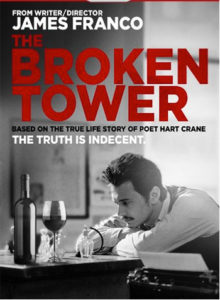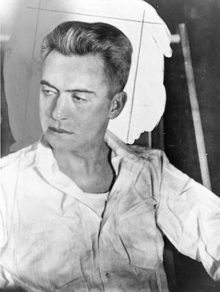 The Broken Tower
The Broken Tower
Written and Directed by James Franco
Based on the book by Paul Mariani
Released June 20, 2011, at the Los Angeles Film Festival
History (biopic)
110 min.
Review by Stephen O. Murray
March 19, 2015.
As a commercial movie, The Broken Tower, written by, produced by, directed by, edited by, and starring James Franco, is untenable. As a master’s (MFA) thesis (at NYU), that is, as a “student film,” its amateur-ness and failure to reach out to potential audiences is more tenable, though IMO Franco the editor is a failure, and I’m none too sure about Franco as a writer.
Franco reportedly was inspired by Paul Mariani’s biography of Crane, also titled The Broken Tower, a line about language from Hart Crane (né Harold, 1899–1932). The succession of images, which seem mostly to be of Crane walking in NYC and Paris, is mostly chronological, with some foreshadowing images of the deep blue sea (dark gray on black-and-white stock), though there are several scenes of Crane being fired from jobs, one of him chopping wood, one of him performing fellatio (and I do mean “performing,” not “simulating performing,” though I am not entirely sure if he is fellating a prosthetic phallus (as Chloë Sevigny did in The Brown Bunny) or a human penis), simulating being anally penetrated by Michael Shannon (whose character’s name, Emil Opffer, a Danish merchant marine, only registers in the closing credits), runs into trouble in Marseilles for a bar tab he could not pay, is fag bashed by some of his desired sailors, and awkwardly reads “For the Marriage of Faustus and Helen” for eleven long minutes in a reenactment of a 1920s NYC poetry reading. (The notorious fellatio scene occurs fifteen minutes in, with 95 long minutes still ahead. There is, btw, no nudity, despite there being two sex scenes, one oral, one anal.)
 Franco does not look at all like Crane (pictured above), not that very many people know what Crane looked like…and fewer still understand his poetry. Through most of the movie, Franco sports a cropped mustache.
Franco does not look at all like Crane (pictured above), not that very many people know what Crane looked like…and fewer still understand his poetry. Through most of the movie, Franco sports a cropped mustache.
Though there is a lot of Franco intoning Crane poetry (not just at the poetry reading), there is rather little dialogue. Nothing other than the Brooklyn Bridge that inspired his poetry appears and the movie cannot be a bildungsroman because there is no “bildung” (growth). Crane is shown as an alienated aesthete as a youth in Cleveland, who continues to love and/or lust after men in New York City, Mexico City, Marseilles, and Paris, having difficulty making a living (though receiving formal and informal grants). Franco’s Crane is a type—the alienated homosexual aesthete who has a lot of sexual encounters, gets beaten up pursuing straight young men, and despairs (killing himself before he can get old in this case).
The handheld camerawork (credited to Christina Voros) is jerky in a pre-Stedicam way (say a 1960s Nouvelle Vague way; Franco is on record as admiring Godard’s cubist Vivre sa vie) that likely annoys mainstream audiences (including Franco fans) as much as the pretentious reading of difficult poetry does. There was much more entertainment and information in Howl, in which Franco played Allen Ginsberg. He definitely is into impersonating poets, planning to do Charles Bukowski next (I don’t see much similarity between Crane’s poetry and that of Ginsberg and Bukowski; Keats has recently been done, I guess, though Ginsberg has been done multiple times in recent years, as Capote writing In Cold Blood has).
Rating: 1.5/5
Pros: some black-and-white images
Cons: concept of biopic, execution, long recitations of Crane poetry
(Franco subsequently made a horrible adaptation of my favorite Faulkner novel, As I Lay Dying, and a surprisingly good one of Steinbeck’s In Dubious Battle.)
© 19 March 2015, Stephen O. Murray

